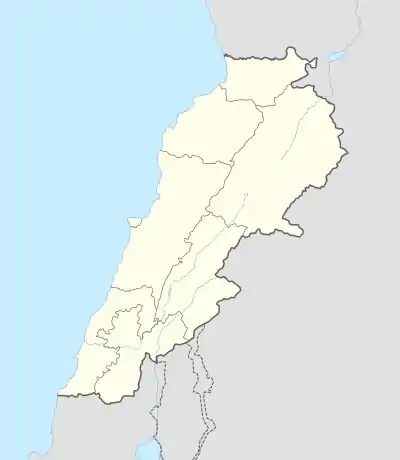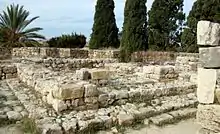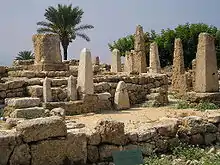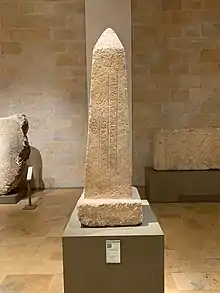Temple of the Obelisks
The Temple of the Obelisks (French: Temple aux Obelisques, Arabic: معبد الأنصاب maebad al'ansab), also known as the L-shaped Temple and Temple of Resheph[1] was an important Bronze Age temple structure in the World Heritage Site of Byblos.[2] It is considered "perhaps the most spectacular" of the ancient structures of Byblos.[3] It is the best preserved building in the Byblos archaeological site.[4]
_6.jpg.webp) Temple of the Obeliques, Lebanon. | |
 Shown within Lebanon | |
| Location | Byblos |
|---|---|
| Coordinates | 34°07′08″N 35°38′50″E |
| Site notes | |
| Excavation dates | 1922 |
Almost all of the artefacts found in the excavation of the temple are displayed at the National Museum of Beirut.[5] It was excavated by French archaeologist Maurice Dunand from 1924-73. The original temple is now in two parts: the base is known as "the L-shaped temple", and the top is known as the "Temple of the Obelisks"; the latter was moved 40 meters east during Maurice Dunand's excavations.[6]
Dunand uncovered 1306 Byblos figurines – ex-voto offerings, including faience figurines, weapons, and dozens of bronze-with-gold-leaf figurines – which have become the "poster child" of the Lebanese Tourism Ministry.[7]
Description
Base: L Shaped Temple

The L-shaped Temple was constructed around 2600 BCE,[8] two centuries after the construction of the Temple of Baalat Gebal (approximately 100m to the west) had been built.[8] It was named the "L-shaped" temple by Dunand, as its two rooms and the courtyard were arranged in such a shape.[8]
The temple had well built walls and temples, in contrast to the later Obelisk temple.[6] It is thought that the L-shaped temple was burned down at the end of the Early Bronze Age.[9]
Top: Obelisk Temple

The Temple of the Obelisks was constructed around 1600–1200 BCE on top of the L-shaped temple, retaining its general outline.[6] The temple's name, given by Dunand, refers to a number of obelisks and standing stones located in a court around the cella.[9] The Abishemu obelisk has been interpreted to include a dedication to Resheph, a Canaanite war god, although this is disputed.[9] Another obelisk has a hieroglyphic inscription Middle Bronze Age king of Byblos Ibishemu, praising the Egyptian god Heryshaf.[9]
Since it had been built on top of the L-shaped temple, it was necessary for Dunand to dismantle and move this upper temple in order to excavate the L-shaped temple beneath.[6]
In contrast to the L-shaped temple beneath, the Obelisk Temple was built with irregular walls.[6]
Modern identification and excavation
The temple was first identified by Dunand.[10][9] The majority of the obelisks found were underground in their original positions, standing upright, while a few others were discovered buried in a favissa (a well for votive deposits).[9]
 1959 view of the temple base and top
1959 view of the temple base and top Montet's 1924 diagram of the Byblos archaeological site
Montet's 1924 diagram of the Byblos archaeological site Montet's 1924 diagram of the Byblos temples.jpg
Montet's 1924 diagram of the Byblos temples.jpg The Byblos figurines
The Byblos figurines The Abishemu obelisk
The Abishemu obelisk
Further reading
- Boda, Sharon La (1994). International Dictionary of Historic Places: Middle East and Africa. Taylor & Francis. ISBN 978-1-884964-03-9.CS1 maint: ref=harv (link)
- Michaelides, Demetrios (2001), Report on Mission to Byblos (Lebanon), International Council on Monuments and Sites
- Bryce, Trevor (10 September 2009). The Routledge Handbook of the Peoples and Places of Ancient Western Asia: The Near East from the Early Bronze Age to the Fall of the Persian Empire. Routledge. ISBN 978-1-134-15908-6.CS1 maint: ref=harv (link)
- Kilani, Marwan (24 October 2019). Byblos in the Late Bronze Age: Interactions Between the Levantine and Egyptian Worlds. Brill. ISBN 978-90-04-41659-8.CS1 maint: ref=harv (link)
- Maura Sala, Temple En L A Biblo, Vicino Oriente XIV (2008), pp. 61–87
- Finkbeiner, Uwe (1981). Untersuchungen zur Stratigraphie des Obeliskentempels in Byblos: Versuch einer methodischen Auswertung. G. Mann.
- Miniaci, Gianluca. Deposit f (Nos. 15121–15567) in the Obelisk Temple at Byblos: Artefact Mobility in the Middle Bronze Age I–II (1850–1650 BC) between Egypt and the Levant, Aegypten und Levante 28, 379-408.CS1 maint: ref=harv (link)
Archaeological reports
- Dunand, Maurice (1937). Fouilles de Byblos: Atlas : 1926-1932. P. Geuthner.CS1 maint: ref=harv (link)
References
- Kilani 2019, p. 57a...based on a disputed translation of the Abishemu obelisk
- Boda, Sharon La (1994). International Dictionary of Historic Places: Middle East and Africa. Taylor & Francis. p. 146. ISBN 978-1-884964-03-9.CS1 maint: ref=harv (link)
- Michaelides, Demetrios (2001), Report on Mission to Byblos (Lebanon), International Council on Monuments and Sites, p. 21
- Kilani 2019, p. 57.
- Michaelides 2001, p. 21.
- Boda 1994, p. 146.
- Steiner, Margreet L.; Killebrew, Ann E. (2014). The Oxford Handbook of the Archaeology of the Levant: C. 8000-332 BCE. OUP Oxford. pp. 465–. ISBN 978-0-19-921297-2.
- Bryce 2009, p. 138.
- Kilani 2019, p. 57-58.
- Dunand 1937.
External links
 Media related to Temple of the Obelisks at Wikimedia Commons
Media related to Temple of the Obelisks at Wikimedia Commons